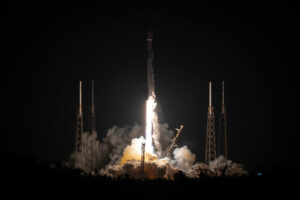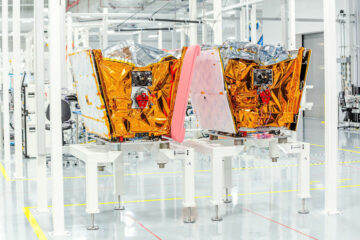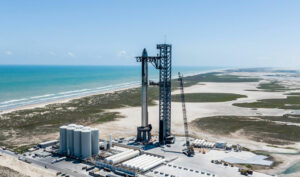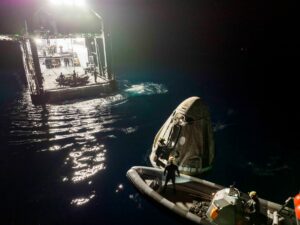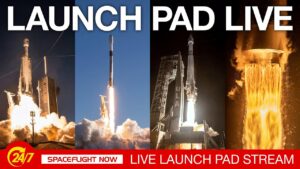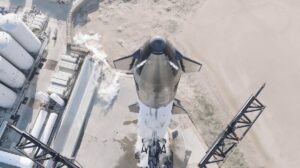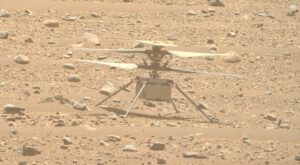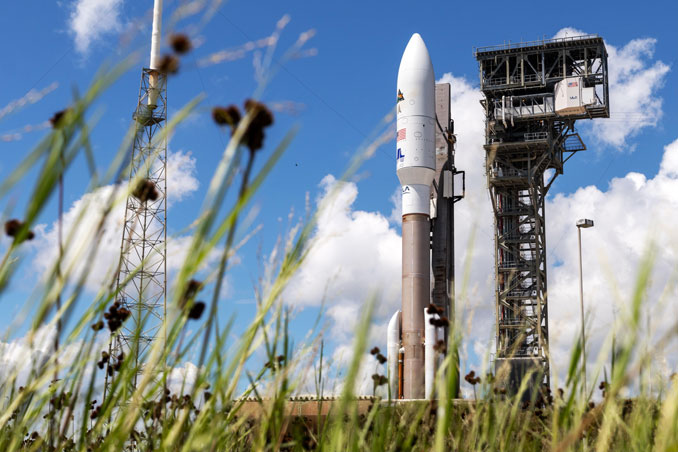
Meteorologists forecast Tropical Storm Idalia to become a major Category 3 Hurricane by the time it makes landfall on Wednesday. Late Monday evening, ULA announced it would roll the rocket back to the safety of the Vertical Integration Facility (VIF) ahead of the storm “out of an abundance of caution for personnel safety” as well for the safety of “a critical national security payload.”
Earlier in the day during a pre-launch press conference discussing the mission, dubbed NROL-107 or Silentbarker, ULA President and CEO Tory Bruno noted that the probability of violating weather at the planned launch time of 8:34 a.m. EDT (1234 UTC) on Tuesday, Aug. 29, was only 20 percent, but that flipped to 80 percent chance of no-go weather for the backup launch opportunity.
“The concern will be high winds. We can take about 54 knots sitting on the pad and so, if we can’t make that, then our next opportunity on the range is a few days off,” Bruno said. “I won’t give you the date yet because it’s still in coordination, but we’ll have to wait.”
If ULA had rolled the dice and made an attempt on Tuesday but had not been able to launch, there would not have been time to move the Atlas 5 before bad weather arrived.
“It takes us 24 hours once we’re fully tanked to get our cryos [liquid propellants] back off so we can roll back to the VIF and button it up to protect if from the winds,” Bruno explained Monday morning.
[embedded content]
The Silentbarker mission will send a satellite to geostationary orbit (GEO) on behalf of the National Reconnaissance Office (NRO) and in partnership with the U.S. Space Systems Command, part of the U.S. Space Force.
During Monday morning’s press event, NRO Director Christopher Scolese described it as a “watchdog” to track other satellites in the GEO space.
“You’ve heard about communications satellites moving from one location to another to provide better coverage for other areas. Certainly, we want to be able to see that, so we know what is going on in that area,” Scolese said. “But we also want to know if there is something going on that is unexpected or shouldn’t be going on that could potentially represent a threat to a high-value asset, either ours or one of our allies’.”
NROL-107 will be the first of at least two mission launches supporting the Silentbarker program, according to Scolese, with initial operational capability beginning in 2026. This launch aboard the Atlas 5 rocket will include more than one payload, but officials declined to go into further detail.
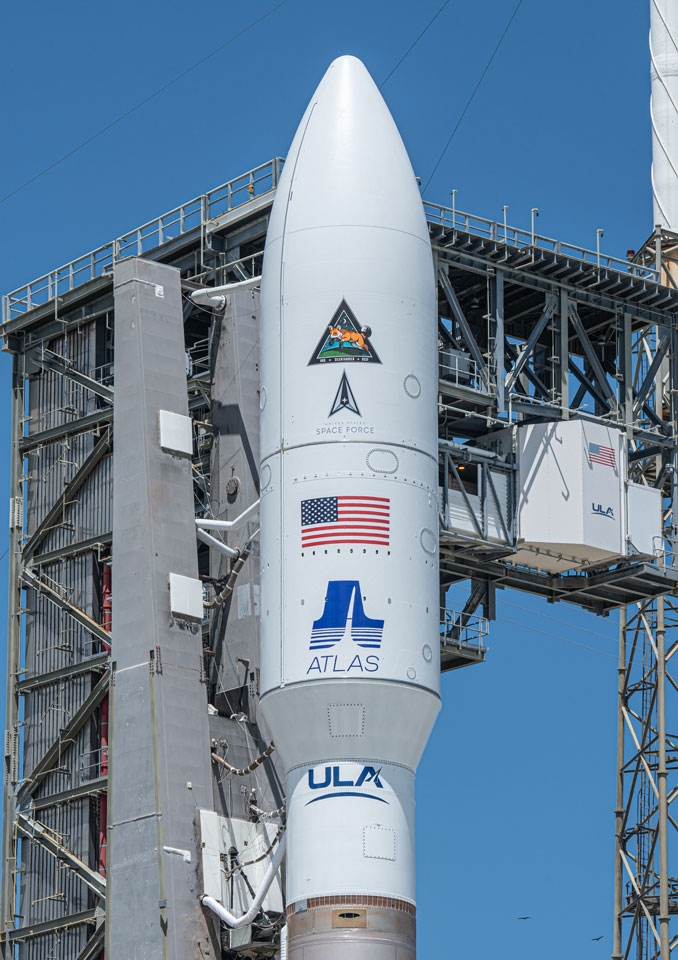
Lt. Gen. Michael Guetlein underscored the significance of the mission in his opening remarks on Monday.
“The capability that we’re going to launch… goes a long way towards giving us the competitive endurance, competitive advantage in space to make sure we can not only see, but maintain custody of the threats in GEO,” Guetlein said.
ULA will determine a new launch date after the storm passes in coordination with the NRO and SSC.
- SEO Powered Content & PR Distribution. Get Amplified Today.
- PlatoData.Network Vertical Generative Ai. Empower Yourself. Access Here.
- PlatoAiStream. Web3 Intelligence. Knowledge Amplified. Access Here.
- PlatoESG. Automotive / EVs, Carbon, CleanTech, Energy, Environment, Solar, Waste Management. Access Here.
- PlatoHealth. Biotech and Clinical Trials Intelligence. Access Here.
- ChartPrime. Elevate your Trading Game with ChartPrime. Access Here.
- BlockOffsets. Modernizing Environmental Offset Ownership. Access Here.
- Source: https://spaceflightnow.com/2023/08/29/tropical-storm-idalia-delays-national-security-atlas-5-launch/
- :is
- :not
- $UP
- 20
- 2026
- 24
- 8
- 80
- a
- Able
- About
- abundance
- According
- Adam
- ADvantage
- After
- ahead
- Alliance
- also
- an
- and
- announced
- Another
- AREA
- areas
- AS
- asset
- At
- atlas
- Aug
- back
- Backup
- Bad
- BE
- because
- become
- been
- before
- Beginning
- behalf
- Better
- Bruno
- but
- button
- by
- CAN
- capability
- Category
- caused
- caution
- ceo
- certainly
- Chance
- Christopher
- Communications
- competitive
- Concern
- Conference
- content
- coordination
- could
- coverage
- critical
- Custody
- Date
- day
- Days
- delays
- described
- detail
- Determine
- Director
- discussing
- down
- dubbed
- during
- either
- embedded
- evening
- Event
- explained
- Facility
- few
- First
- florida
- For
- Force
- Forecast
- from
- fully
- further
- Gen
- get
- Give
- Giving
- Go
- Goes
- going
- had
- Have
- heard
- High
- his
- HOURS
- http
- HTTPS
- hurricane
- if
- image
- in
- include
- initial
- integration
- into
- IT
- jpg
- Know
- Late
- launch
- launches
- least
- Liquid
- location
- Long
- made
- maintain
- major
- make
- MAKES
- max-width
- Michael
- Mission
- Monday
- more
- morning
- move
- moving
- National
- national security
- New
- next
- noted
- now
- of
- off
- Office
- officials
- on
- once
- ONE
- only
- opening
- operational
- Opportunity
- or
- Orbit
- Other
- our
- pad
- part
- Partnership
- passes
- percent
- Personnel
- planned
- plato
- Plato Data Intelligence
- PlatoData
- player
- potentially
- president
- press
- probability
- Program
- protect
- provide
- range
- represent
- rocket
- Roll
- Rolled
- s
- Safety
- Said
- satellite
- satellites
- Secret
- security
- see
- send
- shrouded
- significance
- Sitting
- So
- something
- Space
- Space Force
- stand
- Still
- Storm
- Supporting
- sure
- Systems
- Take
- takes
- Tanked
- than
- that
- The
- then
- There.
- this
- threat
- threats
- time
- to
- top
- towards
- track
- Tuesday
- two
- u.s.
- U.S. Space Force
- Unexpected
- United
- us
- UTC
- vertical
- Video
- Violating
- wait
- want
- was
- Way..
- we
- Weather
- Wednesday
- WELL
- What
- What is
- will
- winds
- with
- would
- yet
- you
- youtube
- zephyrnet

